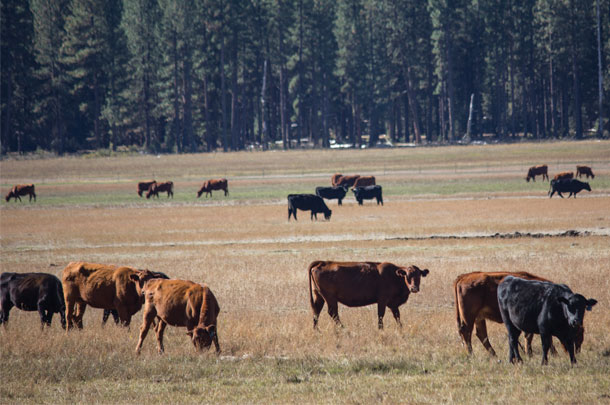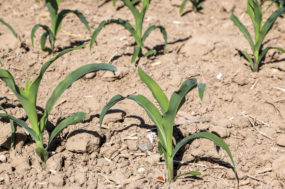This has created very strong demand from timber companies across the Pacific Northwest to aggressively purchase land holdings of various sizes. I’m having buyers call on a regular basis looking for timbered acreage ranging in size from 100 to 100,000 acres.
Opportunity for ranchers
There are always proactive ranchers looking for opportunities to expand and secure their land bases. One opportunity today is for ranchers to sell their timberland holdings, lease back the grazing rights long term, then use the proceeds from the sale to purchase more land. Ranchers are also using the proceeds to pay off debt, making themselves more financially secure.
Timbered properties have value for grazing in that they offer good-quality late-season feed. They do, however, tend to lack in grass production when compared to open rangeland. It is not uncommon to see grasslands with double the animal units for half the cost of timberland.
Making this kind of trade can allow ranchers to greatly expand carrying capacity. Selling the timberland and leasing back the grazing long term has potential as an estate-planning tool as well.
How valuable is timberland?
There are really two broad types of buyers who drive the value of your timbered acreage: timber companies and amenity buyers. The timber companies, of course, are interested in the timber, while amenity buyers are interested in having a cabin in the woods. Both are different but can potentially offer the same opportunities for ranchers wanting to make the land trade.
Timber companies are looking at how much timber, what kind of timber and what costs are associated with getting it to the mills. Here in northeast Oregon, timber companies want to see high volumes of fir and larch species. In areas with wetter climates, cedar trees add much value and demand to the landscape.

The costs timber companies look at when estimating land value are how far it is to the mill and harvest costs. Trucks run in the range of $90 per hour, which adds up quickly. Modern-day sawmills operate on a fraction of the manpower of older mills. This is lowering overheads enough to make it feasible to haul from areas that were not economical just a few years ago.
The harvest process has a large price range, mostly determined by slope. The steeper the slope, the higher the cost is to harvest the timber. Mechanical harvest, common on flatter slopes, is nearly half the cost as line-logging found on steeper slopes. It isn’t uncommon to go through a timbered property and find all the flatter slopes have been harvested with all the steeper slopes very well stocked.
Timber companies will move quickly with a short escrow period if the title report shows no clouts (easements, or not owning the hunting rights, for instance) and the timber cruise (the timber-harvesting quantity evaluation) shows positive results. Most timber companies are purchasing with cash.
Cattle are a benefit to almost all timber companies. Grazing reduces fuel loads, which reduces the chances of valuable timber burning up in a wildfire. I have seen grazing leases with terms as high as 99 years for very reasonable rates.
The amenity buyers drive mostly the rest of the market for timbered land. Ranchers and environmental groups make up most of the remaining few. The amenity buyers want a place to recreate – often with just a cabin in the woods. Some look at their place of recreation as an investment with annual growth.
Most forests in eastern Oregon get 3 to 5 percent growth annually. Water resources, such as streams, rivers and lakes, will increase the demand from this group. Great hunting on or near the property helps with the demand as well as distance from the nearest towns.
Demand is strong from amenity buyers. The economy is doing well, and millennials are joining baby boomers in the buying market. It is not uncommon to see the amenity value exceed the timber value, even with the high timber prices we are seeing today.
The difference between a heavily stocked and lightly stocked forest seems to show little significance on land value if amenity buyers are involved. There’s a large significance in the emotional aspect when it comes to the purchase from these buyers. This leads to higher prices, but often the listing is on the market longer to find the right buyer. Leasing back grazing rights is common after the sale.
Occasionally, producers get to lease back the grazing for free. However, it isn’t uncommon to hear of dysfunctionality in grazing leases. I know several people who quit grazing leases because they were too much trouble. People who buy these properties often come from urban areas with little knowledge or experience in this field.
Should I log before I sell?
The main difference you see from a marketing perspective between a timber property that is well stocked and one that has been harvested is liquidity. If your property is well stocked, timber companies are going to want it, even if it’s smaller in size. Timber companies tend to pay in cash with a quick closing. I’ve seen properties close within two weeks of being put on the market.
If you aren’t in a hurry to sell, and the location is desirable, you might be ahead to harvest timber before putting the property on the market. The value of timberland doesn’t seem to make a large dive if you don’t excessively harvest. Buyers have even told me they don’t want densely timbered areas; they want to be able to look through their property and want a reduced fire risk.
The opportunities are out there with a strong timber market. Having a vision for the future of your ranch, a knowledgeable accountant, an experienced tax attorney and a land professional are key to pulling this off. Not following IRS guidelines and having a good understanding of the value of your land can get you into more trouble than anything else. ![]()
PHOTO 1: Heifers graze a meadow in fall surrounded by heavily timbered range in northern California.
PHOTO 2: The timber market can help grow your ranch. Photo by Lynn Jaynes.
Caleb Howard is a real estate sales/land manager with Farmers National Company. Email Caleb Howard.







